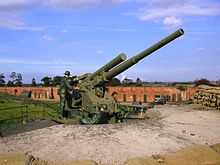Fort Paull

Fort Paull is a gun battery situated on the north bank of the Humber, near the village of Paull, downstream from Hull in northern England.
Batteries have been built at Paull by Henry VIII, Charles I during the Civil War during the siege of Hull and the Napoleonic Wars. The current fort is of pentagonal design and was built in 1861-4 and on the recommendations of the Royal Commission, hence it is one of the Palmerston Forts. The original emplacements, nineteen 64 pounder (29 kg) RML artillery pieces were almost completely demolished in 1894 when concrete emplacements for three disappearing guns and two quick firing guns were built. A mining station was added in 1886 and searchlights followed in 1907.
At the outset of the First World War, Paull was judged too close to Hull, so was disarmed when new forts were built at Sunk Island and Stallingborough. The fort was used as a training base between the wars, and during the Second World War, it was converted into a magazine to serve the Russian convoys; a degaussing station was also added.
In 1960, Fort Paull was released from the Ministry of Defence and closed down. In 1964, a group of volunteers, the Friends of Fort Paull took over the site and began to restore the fort as a heritage museum. Fort Paull finally opened to the public in 2000. Fort Paull houses a waxwork museum showing figures which have influenced the fort's long history as well as an armoury showing various artillery pieces and armoured vehicles. The fort also plays hosts to various military reenactments from time to time.
Fort Paull is the location of the last remaining complete Blackburn Beverley heavy transport aircraft.[1]
References
- ↑ "Fort Paull, East Riding". The Heritage Trail. Retrieved 2 March 2011.
External links
| Wikimedia Commons has media related to Fort Paull. |
Coordinates: 53°42′48″N 0°13′46″W / 53.713360°N 0.229450°W